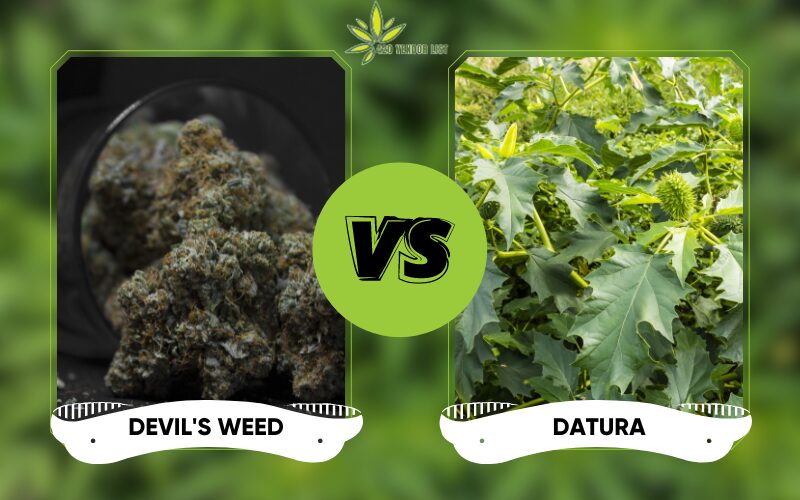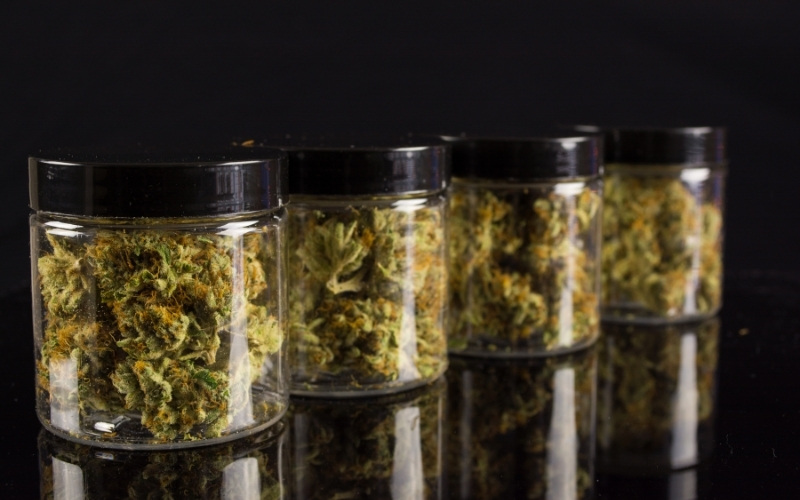
There are two weeds that are famous in both the gardening world and the cannabis world. Devil’s Weed by itself already comes with an ominous name, but is it really a bad weed? Opposite from it is Datura, another mysterious weed with possible adverse effects. How are both similar but also very different? Should you try these weeds? Read more to learn about devil’s weed and Datura as well as how both compare and contrast with one another.
What Is Devil’s Weed?
Devil’s weed is an indica-dominant hybrid cannabis strain that became available in the 1980s thanks to Mr. Nice, a.k.a. Shantibaba, a famous breeding pioneer. The Australian grower developed devil’s weed using Afghan and Afghan skunk parent strains. Little did he know just how much of a hit Devil’s Weed would be to the cannabis industry. It is now considered a classic for its cerebral buzz and the tranquil state it puts users in.
Devil’s Weed Appearance, Taste, and Aroma

Each part of devil’s weed is inviting. Its flowers are angelic in appearance; however, its effects can be a knock-out on a Friday night. Its flowers take the form of small clusters with colors ranging from off-white to pale purple. The small fruits contain fluffy white hairs. These are what makes the flowers and consequently the seeds spread through water or wind. These hairs are similar to a velcro material which means they can cling to animals and people that pass by.
Unlike other Afghan weed strains, devil’s weed produces fewer amounts of resin. It has a spicy aroma and a smell similar to rotten wood. The taste is sweet and earthy, which is attributable to its parent strain, Afghan Skunk.
How To Grow Devil’s Weed
Due to the low cultivation requirements, devil’s weed is an excellent choice for both novice and experienced growers. In addition, this weed strain is mold and pest resistant. As part of the Devil phenotype, it still needs to be developed before cannabis enthusiasts can make a perfect strain.
You may opt to grow it indoors, outdoors, or even in a greenhouse, however, it’s best to grow it outdoors for a yield of up to 600g per plant. In terms of height, it can grow to up to 72 inches, and overall is a medium-sized plant with a moderately difficult growing level. In an indoor setting, you should expect to harvest around 300g. You’ll need to leave it in its vegetative state for about 14 days to increase outputs. The flowering time is roughly eight weeks.
In the North, this plant can usually be harvested by the time October swings around. On the other hand, June or July is the way to go in the Southern hemisphere. Expect to see the luscious and vibrant colors after a relatively smooth-sailing growing experience.
What Are The Effects Of Devil’s Weed?
Devil’s weed contains THC levels ranging between 15% and 17%. It provides users with a physical and cerebral high. Some smokers add that this weed strain takes you on an uplifting and exploratory journey of the mind. It may also produce powerful couch-lock effects, therefore, this strain is best reserved for chill and relaxing days. Intake has also been known to lead to hallucinations and delirium for some individuals smoking the devil’s weed.
As for its medical benefits, traditionally it was known to treat asthma, although, this could also lead to adverse effects. Other users mention that it helps improve insomnia while reducing anxiety and depression levels. Additionally, it is used by some for Cachexia, hypertension, and anorexia. Whether to calm the body or relieve parts of the body from pain, devil’s weed provides a heady experience that can calm one’s mind.
Is Devil’s Weed Safe?

If not, that could very well be a different kind of weed. This is because another plant also uses the term “devil’s weed” as its nickname. This is where it can get tricky; however, when you understand the differences between devil’s weed and Datura, you have to weigh which one is right for you.
What Is Datura?
Datura stramonium is a bushy and invasive weed of the Solanaceae nightshade family. It has oval-shaped leaves, hollow stems, and produces sweet-smelling flowers in three colors: red, green-white, and yellow. It produces knobby, acidic-tasting fruits as well as cylindrical roots and spiny seeds. It is often considered to be a pest in certain parts of America, with its eradication an important cause for some residents. Unlike that of a cannabis strain, its “high” can be toxic instead of pain-relieving.
Datura Background
Datura grows naturally in temperate climates, which usually have clay-loamy soils. These regions include India and some parts of the Himalayas. The plant is also present in countries with calcareous soil like Uganda, Bangladesh, and Mexico.
These hallucination-inducing plants were allegedly used by Delphic oracles in ancient Greece as a way to induce their prophetic visions. This weed was used as a “culture plant” often bartered through Asia into the new world, seen as a means to enhance fortune-telling abilities.
To this day Datura is still bought and sold in the Caribbean. It has gained another name, however, “herbe aux sorciers” which means “herb of the sorcerers”.
In Mexico Datura is worshipped through “Santo Toloache”, the patron saint of Datura. In Hindu cultures, Datura is mixed with Ganja and smoked by Yogis to unify both the male and female in self into “oneness”. The name “Datura” comes from the Hindoo “Dhatura”, derived from the Sanskrit, “D’hustúra”. The name “Stramonium” is of uncertain origin, and some authorities claim that it is inherited from the Greek name of the “mad apple”. The seed capsules of the Datura species are usually about the size of a walnut and are covered with thorns. The appearance of these seed-pods has given rise to the English common name, “Thornapple”.
Datura on its own is capable of continuing to grow through the years. Dispersed through the wind carrying its clingy fruits, it can be a menace to deal with if you do want to get rid of it. It needs minimal attention and can spread fast.
Common Names
Datura has numerous local names. These include devil’s trumpet, Jamestown weed, Stramonium jimson weed, prickly burr, purple thorn apple, and stink wort. Its most popular moniker, jimson weed, is a play on Jamestown weed. This was initiated by the herb industry as an allusion to Captain John Smith and his group of English colonizers who first settled in Jamestown.
The band of soldiers failed in their attempt to make a colony in Jamestown in Virginia in 1607. This defeat was attributed to their consumption of jimson weed which they boiled and ate in the form of a salad. The soldiers were mentioned to display strange behavior after eating the plant. The hallucinogenic properties could have caused these actions. The delirium often experienced when taking Datura probably hit the soldiers harder than expected.
In some sections of India, Datura is known as Dhuttura Kanaka/Ummattangani depending on the area where you find this plant.
It also goes by devil’s weed, which some people might mistake for the cannabis strain with the same name; however, both are very different in terms of look, effects, and smell.
Toxicity
Every part of a Datura plant is toxic due to the excessive levels of three deliriants present: hyoscyamine, atropine, and scopolamine. The toxin levels have led to several hospitalizations and fatal overdoses among recreational users. As a result, some states have instituted a ban on the cultivation of devil’s weed. Also, in 1968 the U.S. government banned the sale of OTC products containing Datura.
Keep in mind that the toxicity levels differ for each plant depending on age, geographical area, and the local climate. Those practicing early medicine needed extensive experience and knowledge to ensure they did not harm patients. For instance, one Datura seed contains 0.1mg of atropine. The consumption of anything above 10mg is fatal.
Some of the adverse side effects of smoking or ingesting Datura include:
- Delirium
- Urinary retention
- Hallucinations
- Pronounced amnesia
- Disorientation
- Heightened senses
- Dilated pupils
- Fever
- Anxiousness
- Paranoia
- Dryness of skin and mucous membranes
- elevated Blood pressure
You may experience these symptoms within an hour of ingestion. Plus, these effects may last anywhere from two days to two weeks, making it a detrimental plant to deal with if taken in large doses. Often, doctors may administer physostigmine to counteract the effects.
Datura uses
1. Traditional medicine
One of Datura’s properties, atropine, has medicinal properties that doctors in the early 16th century up to the late 18th century used during surgeries. Some doctors believed Datura juice to be a cure for all inflammations, including burns and blisters. Some use its leaves of Datura stramonium combined with mustard oil for skin disorders. Others still use it for anti-fungal and anti-cancer treatment. They were recommended to deal with infertility. More studies on these uses are still being conducted in order to establish these as scientifically proven.
2. Ayurvedic indications
In Ayurvedic science, Datura falls under secondary toxic herbs. For this reason, those practicing believe that it’s safe when used in small doses. People believe these plants have to go through the Shodhana process to be purified and used. This detoxifies the Datura.
All parts of these plants may be utilized when formulating medicine. Some of the supposed benefits include:
- Remedy for respiratory diseases. Users believe that Datura contains anti-inflammatory properties and is an expectorant. The plant can, therefore, help to improve symptoms of flu and asthma.
- Better cardiac functioning. Due to its antioxidant properties, people believe it helps treat various heart conditions like arrhythmias, heart blocks, and blood clots.
- Improved digestion. Because of its anti-flatulent attributes, Datura may reduce bloating, cramps and promote digestion.
- Due to its believed analgesic effects, it was also used to relieve pain for sprains and other skin-related problems. Oftentimes it is associated with treating ear pain.
3. Occult
Traditionally, some indigenous communities considered Datura a sacred plant and intentionally used it for its hallucinogenic properties. Datura was also a common ingredient in magical potions and brews. During Medieval Europe and England, the notorious weed is often mentioned to have been used as a green ointment used in witchcraft and pagan rituals. Writings from the Renaissance show that they were even used on the armpits and sensitive parts of the vagina. In the mid-1400s to 1500s, Andres Laguna, one of Pope Julius III’s physicians, reported that they believed it took women on journeys through the dreams they had while using Datura.
Final Remarks
Devil’s weed is an excellent hybrid bred from high-quality Afghani seeds. With its gorgeous tint and long-term calming effects, it’s an all-around safe and effective weed. Its moderate-high is perfect for lazy afternoons and weekends. This strain might also help with insomnia and improve your mood. Be sure not to get it confused with Datura, which happens to share the same name but entirely different effects. If you are ready to try devil’s weed, look no further than 420VL! Visit our site today for the best of D.C. resources.

